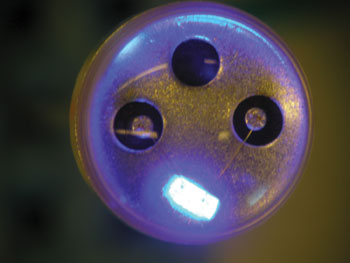Michael A. Greenwood
Blue LEDs with high quantum efficiency and significantly reduced polarization-related internal electric fields have been successfully fabricated on freestanding semipolar substrates by researchers at the University of California, Santa Barbara.

An LED chip fabricated on a semipolar substrate is packaged on a silver header and under direct current of 20 mA. Courtesy of the University of California, Santa Barbara.
Although multiquantum-well LEDs have been grown along various semipolar orientations before, their output power has been compromised.
To improve performance, the team produced devices on recently available high-quality semipolar bulk gallium nitride substrates. The devices consisted of a 1-μm silicon-doped n-type GaN layer, a stack of six multiquantum wells with 20-nm undoped GaN barriers, and 3-nm InGaN quantum wells ending with an undoped 16-nm-thick GaN barrier and a 10-nm undoped AlGaN electron-blocking layer and a 200-nm magnesium-doped p-type GaN layer. The research team was led by Hong Zhong, Shuji Nakamura, Steven P. DenBaars and James S. Speck.
Conventional photolithography and plasma etching techniques formed mesa-shaped LEDs 200 × 550 μm2. They were packaged onto a silver header encapsulated with a silicone dome. The researchers found that LEDs grown on the semipolar substrates had no blueshift of the peak emission wavelength and had enhanced efficiency at higher drive currents compared with c-polar oriented counterparts. A semipolar crystal orientation has a 0° to 90° tilt with respect to the c-polar orientation, on which most commercial LEDs are grown.
With a forward current of 20 mA, the semipolar device achieved an output power of 16.21 mW and an external quantum efficiency of 29 percent. The device had a peak emission wavelength of 444 nm. The high efficiency and power of the LEDs are attributed to the low level of defects afforded by the bulk GaN substrate.
The researchers found that the quantum efficiency of the semipolar LED decreased slightly as the drive current was increased beyond 20 mA. A drive current of 100 mA resulted in 67.11 mW of output power and a quantum efficiency of 24 percent. The magnitude of the efficiency decrease with increasing drive current, however, was smaller for the semipolar LEDs than for those with a c-polar orientation.
The researchers said that LEDs fabricated on semipolar substrates could be commercially practical for a variety of solid-state lighting applications. One drawback is that the semipolar substrate material is currently expensive and scarce, but they said that prices should drop in the near future as production and demand increase.
The technique is being fine-tuned to optimize the layers in the device to achieve higher power output and efficiency with the goal of commercialization. The team also is working on a green LED using the same method, a more challenging task because the polarization effect is more severe.
Zhong said that the group also has demonstrated laser diodes fabricated on the semipolar substrates.
Applied Physics Letters, June 4, 2007, 233504.